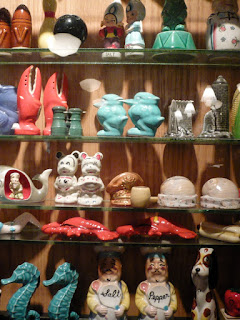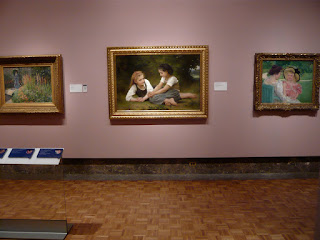After a brief stop through the land of Zingerman's Deli empire (Ann Arbor), I arrived in Detroit.
I was staying with the parents of my friend Chris from college. As Chris' dad had charmingly written when their travel plans were still in flux, "In the next week, I will know for sure if the B. Bed and Breakfast will be open for business. It has received high ratings for visitors, although you would have expected that, Amy."
Owing to travel schedules, it was just Chris' mom and me. The timing worked to pick her up from the airport, which was a nice way to get directions. That night, we visited and had minestrone - with pesto! (A family tradition I experienced in Portland at Chris').
The next morning I met Charlie Shaw, the head of upper school at Cranbrook, a very special collection of schools that includes everything from kindergarten to 12th grade, plus a well-known graduate program in studio art. The campus was largely designed by Saarinen, and is beautiful. It is an experiment in art in education or art in everyday life. The founding patrons, the Booths, had strong ideas along these lines. I was being welcomed on the coattails of Chris' kindness and enthusiasm and good nature, and people could not have been nicer. Here is Charlie in his office:
(A lot of the art on the walls is by students.)
Mary Ellen, who works with Charlie, even printed Mapquest directions for me to get to my next stop.
Charlie drove us around the campus in my car. This is the girl's school, which was built last and is said to be the most unified in design:
I loved the weaving studio:
And was amazed by how much students live around these architectural treasures in an everyday way.
Mary Ellen then drove me to meet with Greg, the really nice director of the Cranbrook museum.
The art museum is closed for renovation. We saw a great Richard Barnes show in the science museum. (The show, Animal Logic, features photographs of taxidermized animals as they are kept in storage and other ways of seeing the diorama presentation of natural history as constructed. They happen also to be beautiful and arresting.) Borrowed from Barnes' website:

Greg knew the gallery guard--something I always find telling and heartening in equal measure--a graduate student named Wes who had just finished his studio work for the term.
Greg and I sat in the cafe and chatted for a long time. His wife studies violence in images. Greg said the average tenure of a museum director is four years. He has been there for twenty-four. As Greg said, "you have to reinvent your programs but you also have to reinvent yourself." He cites "heroic efforts of a small staff" in the museum's ability to play on a bigger stage.
It is specifically an art museum in an art school, part of greater Cranbrook. The art academy is graduate education only, all funded, with no undergraduates for the grad students to help teach. As Greg said, "Talk about a bad business model."
On the walk up to lunch, I learned my favorite detail. The Booths built the school, at a time you built a bowling alley in the basement. The founding patron was alive and also living across the street. If he wanted to change out part of the installation, he simply walked the object over from his house. Thus, the art museum had a bowling alley but also no closets. In earlier renovation, the bowling alley became storage.
In the dining hall pictured above, I had lunch with Greg, Charlie, and a colleague of theirs named Jim, who had had a first job dealing European cars. I learned a lot. Charlie kindly said he hoped it was the start rather than end of a conversation.
They sent me on my way to the Detroit Institute of Art (DIA) where the lovely Nancy Jones, director of education, gave me a marathon tour of their reinstallation. After a couple of hours I had to remind her I had written about museum legs after all and point out her generosity with her time.
The DIA is huge, not to scale with other museums the way a linebacker would look in a crowd of regular people. It's one-way to drive around and park, and the building just keeps going and going. We started at Diego Rivera's Detroit Industry,
a famous mural that was for many years the first sight coming into the building.
Nancy had spearheaded a move within the museum to interpret their permanent collection differently. She had gotten buy-in impressively, hired an interdisciplinary staff, and set about to write wall texts to specific purposes. Here are two examples to give a feel. I should say, museum workers all over the county have been visiting to see it.
1. If you glaze over at Greek vessels, the new installation shows how they were used:
Including this film that further illustrates the uses:

2. In the section of French decorative tableware--a place I personally glaze over--there is this wonderful film projected onto a table that makes it seem like you are having a period meal.
Your seat has a character with period dress sleeves.
The meal is served in the same containers that are in the display cases around the table.
I have never taken such interest in French decorative tableware.
Many other examples abound. Even the overall themes, for instance, how the French aristocracy arranged their day (paintings organized by time-of-day activities), were novel and approachable. And the labels on the paintings created ready-made discussion topics.
That kind of intervention could, in theory, go horribly wrong, but in this case it was playful, spare, and elegant. The materials created a positive feedback loop where my looking was rewarded and caused me to want to look at more stuff (in contrast to glazing over at armor or whatever else). What a nice thing to say about museums: Looking begets better looking. There were even real globes in the galleries so you could see the areas of the world in question -- both the modern-day nation states and the ancient empires shown.
I enjoyed a lot of what I saw, including this landscape:
This Otto Dix is Nancy's favorite:
Here I am with a sculpture (literally a donkey, figuratively a sacrificial lamb) that they keep in the entry hall and that you are supposed to touch so that the real accumulation of fingerprints will show how much they do damage the art.
That evening I met back up with Chris' mom. John Corso, a college friend who teaches art theory at Oakland University, came by and he and I went to Meadow Brook on an epic tour. Meadow Brook Hall is the fourth largest residence in the United States. It is 88,000 square feet. We were excited that it stayed open late on Mondays. Then we got there and realized it was Tuesday. A nice docent let us look around as long as we left at 7pm. Just before 7pm, we ran into an incredibly nice groundskeeper who took us around. I felt like we were sneaking in as he took us down staff passageways, into linen rooms or the children's bedrooms (each with its own separate guest room for friends to stay over). We heard the story of Matilda Dodge and her family while standing in Matilda's bathroom suite, which by New York standards is a four-bedroom apartment. (Our host was a young guy, very knowledgeable, and there was this moment where he said Matilda married her second husband--the first died of influenza with his brother at a New York car show--"when she was around fifty." Immediately another docent materialized, "She was 42 when she married, 46 when she moved into the house." The kind of details women remember, I suppose.
I don't mean to sound cynical at all when I say John and I would make a great con artist team. He was local, teaching at the affiliated university. I was this author just passing through town, one night only. We didn't in any way misrepresent ourselves, but at the end, we both ducked into the coat closet while our host went to get us a brochure. I was hoping we didn't run into our first kindly docent who might have realized how far past 7pm we stayed. John ducked into the closet because, "My provost is out there."
Detroit has a burgeoning film scene. Danny Glover had been filming in town. Parker Posey had been there too. Our host had met her and not known who she was, thereby I think talking to her in a charmingly everyday way. Later realizing who she was, he seemed a bit struck. "She's really cute," I offered, as if he might have noticed something else about her, if not her fame directly. He replied with no hesitation, "She's hot."
And then we picked up takeout from Lamarza, a great Lebanese takeout in Bloomfield Hills, and had dinner with Chris' mom, the three of us. The next day, Chris' mom took me kindly to tour Christ Church Cranbrook. The space was beautiful, in a not-quite-austere way:
I was really struck by these embroidered (bargello?) kneelers:
And loved the water fountain:
Everyone was so kind and welcoming, and also so interesting and delightful to talk to. Greg of the Cranbrook museum, said Adam Lerner of the Denver MCA used to host lectures at a place called the Lab where he would invite disparate speakers and see at what point in the Q&A people started to relate the two thematically. The standout had been TV theme songs and Walt Whitman.
A nod to the United Kingdom, here is the Michigan intersection of Kensington and Charing Cross, on my way out of town:
































No comments:
Post a Comment